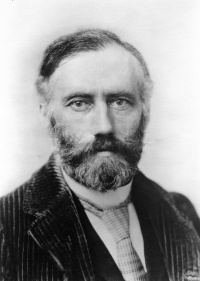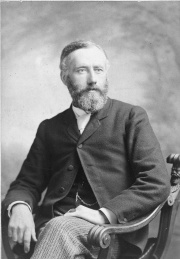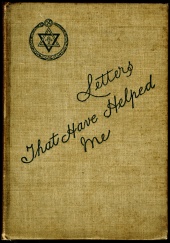William Quan Judge
UNDER CONSTRUCTION
UNDER CONSTRUCTION

William Quan Judge was one of the principal Founders of the Theosophical Society in 1875. He provided superb leadership to the American Section until his untimely death in 1896, but left a body of writings that are among the clearest explications of the principles of Theosophy. See Judge writings.
Personal life
William Quan Judge was born in Dublin, Ireland on April 13, 1851 to Frederick "Fred" Hughes Judge (1822-1880) and Alice Mary Quan.
Fred Judge became a Freemason in 1856.[1] In 1847 he married Alice. They had seven children, of whom William was the third. There were four girls – Lucinda ("Lucy"), Alice, Emily, and Carrie – and three boys – William, John, and Frederick. When only seven years old, William was struck by serious illness and was near death.
During the year of his convalescence, he began to show an interest in mystical subjects. Unaware of his ability to read, the family found him engrossed in books dealing with Mesmerism, Phrenology, Magic, Religion and similar subjects.[2]
Mrs. Judge died in 1858 at the birth of the youngest son. On July 14, 1864, the Judge family emigrated to the United States, sailing on the Inman Liner City of Limerick. Fred Judge initially worked in Brooklyn as a clerk, and later was a merchant of building supplies. Six of the children were with him; Carrie was absent from the household - probably dead before she turned twelve.[3][4] The 1870 census shows Fred remarried to Jennie Minerva Burch, with the six children. William was then studying law.[5]
William married Ella Miller Smith on September 16, 1874. They residence was initially in Brooklyn, New York with Ella's father, Joseph Smith, owner of a shoe store. Their daughter Alice was born on June 13, 1875, but died very young of diphtheria. Joseph Smith seems to have retired, and his son-in-law took over as head of the household, which also included Ella's older sister Joanna.[6][7] Ella, like her husband, was a Methodist, but her beliefs took a stricter form than his, and she never accepted his interest in Theosophy.
Legal and business career
After his schooling was completed, young Judge sought work in the legal profession.
He eventually became a clerk in the Law Office of George P. Andrews, who later became Judge of the Supreme Court of New York... On coming of age, William became a naturalized American citizen in April, 1872, and was admitted to the State Bar of New York one month later. His industry, natural shrewdness and inflexible persistence commended him to his clients and he became, as time went on, a specialist in Commercial Law.[8]
By the autumn of 1874, when he first met H. P. Blavatsky, he was employed in the law office of E. Delafield Smith, U S. Attorney for the Southern District of New York. He represented Madame Blavatsky in her divorce from Michael C. Betanelly, and the divorce was granted on May 25, 1878.
In 1884, after returning to New York after his visit to the Theosophical Society's international headquarters at Adyar, Madras, India, "Judge found his financial prospects greatly improved. He joined the law firm win which Olcott's brother worked."[9]
Meeting Olcott and Blavatsky
Mr. Judge knew Colonel Henry Steel Olcott from the legal community in New York, where they both worked.
After reading Col. Olcott's articles in the New York Daily Graphic (published in March, 1875, as a work entitled People from the Other World) outlinging his experiences as the Eddy homestead at Chittenden, Vt., where some weird Spiritualistic séances were being held, he wrote to the Colonel asking for an introduction to Madame Blavatsky. Eventually the desired invitation came, and resulted in an association that was to last throughout their lives.
Judge became a frequent visitor at H.P.B.'s apartment, at 46 Irving Place, New York, where the founding of the Theosophical Society was soon to take place.[10]
His younger brother John H. Judge was also involved with H.P.B., assisting her in preparing the manuscript of Isis Unveiled for publication. William Quan Judge's wife Ella, however, was actively opposed to his engagement in Theosophical interests.
Communication with Mahatmas
Two letters have been published that were written from Master Morya to Mr. Judge. See Letter 1 and Letter 2. As with the "1900 Letter" of Annie Besant, doubt has sometimes been cast upon the authenticity of letters received after the death of H. P. Blavatsky in 1891.[11]

Theosophical work
Founding of the Theosophical Society
During a meeting at Madame Blavatsky's rooms on Tuesday, September 7, 1875, a stimulating lecture was given by George H. Felt, who claimed to be able to summon elemental spirits. Colonel Olcott, H. P. Blavatsky, W. Q. Judge, and others agreed that it would be desirable to form a Society to study such phenomena. After several more meetings, by-laws were adopted and officer elected. Colonel Olcott was chosen as President; G. H. Felt and Dr. Seth Pancoast as Vice-Presidents; Madame Blavatsky, Corresponding Secretary; John Storer Cobb Recording Secretary; Henry J. Newton, Treasurer; Charles Sotheran, Librarian; and William Q. Judge was chosen as Counsel to the Society. Its founding became public with an inaugural address by Colonel Olcott on October 30, 1875.[12]
Early years as Vice President
The departure of Madame Blavatsky and Colonel Olcott for India on December 17, 1878 left a huge vacuum in the Theosophical Society. Abner Doublday\Major-General Abner Doubleday was acting President for a short while until Olcott could be in communication again. However, without the stimulus of the salon HPB had kept at the Lamasery, New York's Theosophical activity languished.
1884 work in Europe
1884 visit to Adyar
Formation of American Section
In 1886, Judge proposed to Olcott and Blavatsky that an American Section should be formed. With their approval, he took on the new role of permanent General Secretary. He began publication of his magazine The Path, and wrote many articles to fill the pages.
The Section was greatly invigorated by its first convention, held on October 30, 1886 in the home of Dr. J. D. Buck in Cincinnati.
Expansion of Theosophical literature
1893 World's Parliament of Religions
Judge, as Vice President, headed a delegation of Theosophists at the World's Parliament of Religions in Chicago. Annie Besant and Professor G. N. Chakravarti accompanied him by train from New York, stopping at the Cincinnati Theosophical Society on September 9 to dedicate the lodge's new Theosophical Hall. They were joined in Chicago by other official representatives of the Society, including the Anagarika Dharmapala, Miss F. Henrietta Müller, and Mrs. Isabel Cooper-Oakley. A Theosophical Congress was held within the greater Parliament on September 15-17. The six delegates spoke to packed halls, supplemented by Theosophists Dr. Jerome A. Anderson, Claude Falls Wright, Mrs. Mercie M. Thirds, Dr. J. D. Buck, and George E. Wright. Newspaper coverage of the event praised the Theosophical Congress and its speakers lavishly, and the event was considered to be a complete success in promoting the tenets of Theosophy and the understanding of world religions. Judge wrote, "being an effort to get on one platform representatives of all religions, it was just what our Society has been accomplishing steadily during the past eighteen years, and what our objects and constitution have always expressed."[13]
Editorial work and writings
Mr. Judge was a proficient writer and editor. His works are among the clearest explications of the principles of Theosophy. See Judge writings.
Correspondence

Mr. Judge conducted an extensive correspondence with Madame Blavatsky, Colonel Olcott, A. P. Sinnett, Josephine Cables, and other members of the Theosophical Society. Many were published in The Theosophist and The Path, in these compilations:
- Judge, William Quan, and Julia Keightley. Letters That Have Helped Me . Available at Theosophical University Press Online. These letters form a conversation between "Jasper Niemand," the pseudonym used by Julia Keightley, and "Z," representing Judge. See also these sources: Theosophy World, ULT, London, and Hathitrust.
- Mavalankar, Damodar K. Damodar, The Writings of a Hindu Chela compiled by Sven Eek. See also Biographical notes. Originally published in 1940 by Theosophical University Press, Point Loma, California. Six letters written to Judge by Damodar K. Mavalankar are reproduced from originals held in the Archives of the Theosophical Society based in Pasadena, California.
- Bowen, Patrick D. and K. Paul Johnson, eds. Letters to the Sage: Selected Correspondence of Thomas Moore Johnson Volume One: The Esotericists. Forest Grove, OR: The Typhon Press, 2016.
Death
Mr. Judge had been ill for some time, from lingering results of Chagas disease (often erroneously referred to as Chagres fever) contracted in Venezuela. His friend Ernest Temple Hargrove wrote to Dr. J. D. Buck early in 1896:
I think that Judge is ten per cent weaker than when you saw him. Today and last night his cough seemed rather better; the mucus came away more easily. But he can hardly walk. He asked me last night "use your intuition. How long do you think this can last?" I said "If it goes on not more than a week." That was in reference to a crisis through which both he and I thought he was passing. For the drop was very sudden--ten percent in a day--yesterday. I do not know what caused it; nor does he. There is nothing else at all now. He gets more sleep now during the day.
Truly, even to the lay eye, it is a case full of contradictions, and it is impossible to take any view or form any opinion that is not flatly denied by facts within the next 24 hours. I should not be surprised at anything; not even at seeing him improved 20 per cent in a day.[14]
Mr. Judge passed away on March 21, 1896 in New York.
Tributes and honors
The William Q. Judge Library is at the headquarters of the Temple of the People in Halcyon, California. B. P. Wadia established the William Quan Judge Cosmopolitan Home for university students at the Indian Institute of World Culture. It was a hostel based Theosophical principles.[15]
Many colleagues have written of Judge:
Katherine Hillard
Some little time elapsed before I learned to recognize, under that quiet and rather insignificant exterior, the wisdom, the practical common sense, the humor and the independence of the man. Day by day I learned to know him better, and to trust him more...
To the mystical element in the personality of Mr. Judge was united the shrewdness of the practical lawyer, the organizing faculty of a great leader, and that admirable common sense which is so uncommon a thing with enthusiasts. . . . And blended with the undaunted courage, the keen insight, the endless patience, that made his personality so powerful, were the warm affections, the ready wit, the almost boyish gaiety that made it so lovable.[16]
Obituary in Mercury
Mercury, the journal of the American Section of the Adyar Society published this gracious and conciliatory obituary:
On 21st of March William Q. Judge quitted this sphere of activity. The news saddened all for every heart kept a shrine sacred to the well-beloved co-worker of H.P.B. We remember only his virtues, which were many, his talents which were great, and we know that the good he did for the many years he labored as the Vice-President of the T. S. and Secretary of the American Section will bless his name for all time. All honor to his memory.[17]
Additional resources
Articles
- Anonymous. "William Quan Judge". From Eclectic Theosophical History, June 2006.
- Anonymous. "William Quan Judge." The Canadian Theosophist 20:2 (April 15, 1939), 35.
- William Quan Judge page on Theosophy.net.
- Articles by William Quan Judge at Katinkahesselink.net.
- Anonymous. "William Quan Judge." The Canadian Theosophist 20:2 (April 15, 1939), 35.
- Sunrise Special Issue. Eight articles from Sunrise, April/May 1996:
- "William Quan Judge: A Biographical Sketch" by Kirby Van Mater.
- "The Occult Path" by Sarah Belle Dougherty.
- "Judge's Ideas on Health" by Richard E. Hiltner.
- "Theosophy and Capitol Punishment" by William Q. Judge.
- "Occultism vs Psychic Powers" by John P. Van Mater.
- "Letters That Have Helped Me: A Personal View" by Douglas A. Russell.
- "Judge's Life: A Personal Viewpoint" by Patrick Powell.
- "My First Meeting with William Quan Judge" by Katherine Tingley.
Notes
- ↑ Ireland, Grand Lodge of Freemasons of Ireland Membership Registers, 1733-1923.
- ↑ Boris de Zirkoff, "Judge, William Quan" H. P. Blavatsky Collected Writings Volume I (Wheaton, Illinois: Theosophical Press, 1966), 472.
- ↑ "Frederic Hughes Judge" in the New York, New York, Index to Death Certificates, 1862-1948.
- ↑ New York, State Census, 1865.
- ↑ 1870 United States Federal Census.
- ↑ New York, State Census, 1865.
- ↑ 1880 United States Federal Census.
- ↑ Boris de Zirkoff, "Judge, William Quan" H. P. Blavatsky Collected Writings Volume I (Wheaton, Illinois: Theosophical Press, 1966), 472.
- ↑ Boris de Zirkoff, 473.
- ↑ Boris de Zirkoff, 473.
- ↑ Constance Wachtmeister, "H.P.B. And The Present Crisis In The Theosophical Society" Theosophy in Australasia (July 5, 1895), 5-8. For a more extended quotation see Theosophists.org website.
- ↑ Henry Steel Olcott, Old Diary Leaves First Series (Adyar, Madras: The Theosophical Publishing House, 1974), 135.
- ↑ William Quan Judge, "The Theosophical Congress and the Parliament of Religions" The Path VIII (November 1893), 247-249. Quoted in Echoes of the Orient Volume II, pages 159-160.
- ↑ E. T. Hargrove letter to J. D. Buck. Dated "Thursday, 1896." Cincinnati Theosophical Society Papers. Records Series 20.02.01. Theosophical Society in America Archives.
- ↑ W. Dallas TenBroeck, "Biographical Notes on Sri B.P. Wadia" Keeping the Link Unbroken (Theosophical Research Monographs, 2004), 120.
- ↑ Katherine Hillard, "Why I Became a Theosophist" Theosophical Quarterly (July, 1909), 59-61. Available at Blavatsky Archives.
- ↑ J. Helen Smith, "Obituary" Mercury 2.9 (April, 1896), 276.